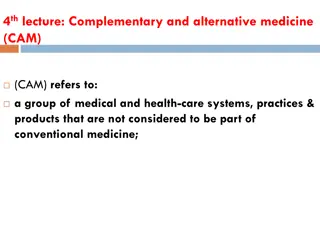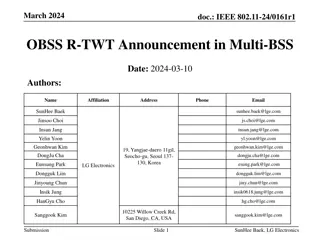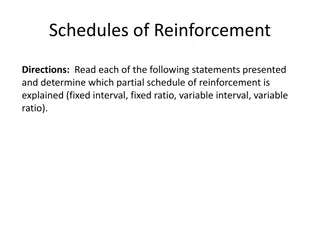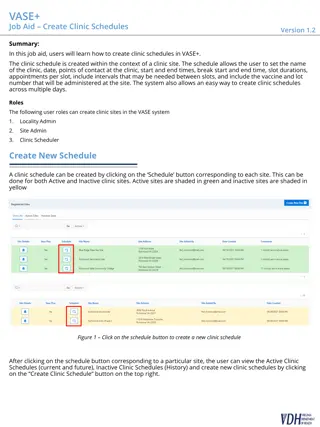Benefits of Alternative Work Schedules: Enhancing Productivity and Work-Life Balance
Explore the advantages of alternative work schedules, such as improved employee dedication, better work-life balance, and benefits to employers, employees, and communities. Learn how flexible scheduling options can meet diverse needs and enhance overall productivity.
Download Presentation

Please find below an Image/Link to download the presentation.
The content on the website is provided AS IS for your information and personal use only. It may not be sold, licensed, or shared on other websites without obtaining consent from the author.If you encounter any issues during the download, it is possible that the publisher has removed the file from their server.
You are allowed to download the files provided on this website for personal or commercial use, subject to the condition that they are used lawfully. All files are the property of their respective owners.
The content on the website is provided AS IS for your information and personal use only. It may not be sold, licensed, or shared on other websites without obtaining consent from the author.
E N D
Presentation Transcript
Alternative Work Schedules
WELCOME! 2
Agenda Definition of an alternative work schedule Advantages Disadvantages Various types of schedules Our alternative work schedule policy 3
Definition of an Alternative Work Schedule Alternative work schedules are alternatives to the traditional nine-to- five, 40-hour workweeks in which work is performed onsite. They allow employees to vary their arrival and departure times or to work a specified number of hours in a pay period. Alternative work arrangements such as flexible work schedules or compressed workweeks are a matter of agreement between the employer and the employee. 4
Advantages of Alternative Work Schedules Alternative work schedules meet the needs of employers by: Having more dedicated employees who can maximize their productive time and minimize the effects of outside responsibilities. Meeting changing and expanding customer expectations and demands, particularly for service and global companies whose customers may be in other time zones or have nontraditional work schedules themselves. Making better use of facilities and equipment by reducing idle time. 6
Advantages of Alternative Work Schedules (cont.) Alternative work schedules meet the needs of employees by allowing them to have a schedule that helps them balance work and life responsibilities, such as: Caring for young children. Being available before or after school hours. Caring for an aging parent. Having nonweekend time to accomplish errands and other personal business. Scheduling exercise and leisure time more easily. 7
Advantages of Alternative Work Schedules (cont.) Alternative work schedules meet the needs of communities by: Reducing traffic congestion with workers on flexible daily schedules, instead of all employees arriving and leaving work at or near the same time. Reducing air pollution and energy demand when employees work a compressed workweek or telecommute. 8
Disadvantages of Alternative Work Schedules Alternative work schedules may present the following challenges: Maintaining ongoing and strong communications with employees on schedules that may vary from their supervisors schedules and who may work offsite all or most of the time. Managing employee relations issues, such as monitoring work and evaluating performance. Handling resentment by employees who are not eligible for or do not participate in the alternative work schedule program. 10
Types of Alternative Work Schedules Alternative work schedules include: Temporary work. Short-term work provided to employees or temporary agency workers to fill in for a regular employee who is on leave or to meet special project or staffing needs. Part-time work. Less than full-time work (generally less than 40 hours per week) provided to meet individual employee needs or the employer s staffing or financial needs and often having a lower level of benefits than full-time work. 12
Types of Alternative Work Schedules (cont.) Job-sharing. Allowing two part-time employees to do the work of one full-time employee by sharing responsibilities, the work schedule and usually the office location. Flextime. Employees are allowed some flexibility in their daily work schedules. For example, rather than all employees working 8:00 a.m. to 4:30 p.m., some might work 7:30 a.m. to 4:00 p.m., and others 9:00 a.m. to 5:30 p.m. 13
Types of Alternative Work Schedules (cont.) Compressed workweek. Employees work fewer but longer days, such as four 10-hour days each week (4/40), or nine-hour days with one day off every two weeks (9/80). Telecommuting. An arrangement by which employees spend all or part of the workweek working outside of the office, such as in their home or in a satellite location. 14
Summary Alternative work schedules are alternatives to the traditional nine- to-five, 40-hour workweeks in which work is primarily performed onsite. Alternative work schedules meet the needs of employers, employees and their communities by improving productivity, creating a better work/life balance and helping curb peak rush- hour traffic congestion and air pollution. 18
Summary (cont.) These schedules may present challenges for maintaining good communication, monitoring and evaluating work, and handling resentment by employees who are not eligible for an alternative work schedule. Types of alternative schedules include part-time work, job-sharing, flextime, compressed workweeks and telecommuting. 19
Training Evaluation Please complete the training evaluation sheet included in the handouts. Thank you for your interest and attention! 21























